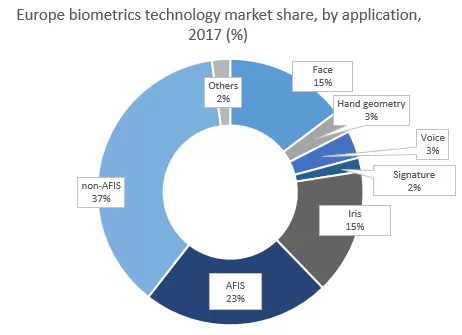Biometrics is a thing that is hardly causing a buzz in social networks or tech world, yet it comprises $14.4 billion market (and projected to reach $59.31 billion by 2025).
Grandview research made a 140-page report on the current state of the technology, its future, current industries where it’s applied more commonly and other details.
You can name the industries that utilize modern upscale identification/authorization technology. Those who use biometrics for their everyday routine and easing up the processes are government organizations, banks and financial institutions, healthcare companies, defence and security providing services and many other spheres.
The scope of application is widening as the technology opportunities grow. We could list consumer electronics as one of the main growing points. Inserting biometrics technology into e-commerce apps enables safe transactions, and that has a positive effect on the market and attracts crazy investment sums.
E-passport programs as a check for migrants status involve biometrics as a primary means for the control used by different authorities and state defence services. Banks and other financial organizations use biometrics to prevent fraudulent activities and increase operational efficiency.
Just by having a look at the above-mentioned areas of application, we could name the technology promising.
As an outsource software development company, we are interested in cooperation with vendors who work on biometrics-related activities and offer their services across different industries.
We’ve decided to explore the overall market, latest trends, use cases, laws, and even scandals – in this complete guide on the looks of biometrics in 2020 consisting of multiple parts.
The definition is a good place to start, though.
What is Biometrics and How Big Is This Market
Biometrics is the technology that enables persons’ identification and authentication judging on a set of unique, specific, recognizable and verifiable data.
The difference between identification and authorization is quite simple. Identification is when a machine (a hypothetical one) asks “Who Are You?”, while authorization is when the same machine wonders: “Are You Indeed the Person that Tries to Get in?”.
Biometric devices, therefore, include the following components:
- A reader (scanning device) to record the biometric factor being authenticated
- Software that converts the scanned biometric data into a standardized digital format/ compares match points of the observed and stored data
- Secure databases to store the biometric data
Our software development company does not produce hardware, so we are able to help your company only if you need the latter two parts of the biometric device comprising software.
Two Types of Measurements
There are basically two types of biometrics measurements:
- Physiological measurements
- Behavioural measurements
Physiological measurements, in turn, divide into morphological or biological. Fingerprints the shapes of the hand/ finger, vein patterns, the retina and iris in the eyes, and the shape of the face are subjects for the morphological analyses.
Biological analyses include DNA, blood, saliva, urines and other body liquids. When we speak of this biometrics, they are often studied by forensic teams and medics.
As for behavioural measurements, the most common among them are voice recognition, signature dynamics.
They also include keystroke dynamics, gestures, but there aren’t too much data storages for such information yet.

Source: growmarmarketreview.com
Based on application, the market has been segmented into the face, hand geometry, voice, signature, iris, automated fingerprint identification system (AFIS), non-AFIS, and other parts.
Elinext had some experience in developing voice and face recognition software as well as data storages for biometrics.
We’ll have a thorough market study in our future publications. As for now, it is just for our readers to have a general understanding of what it looks like in a nutshell.
Biometrics: A Couple of Words on the Current Trends
The world is a pretty different place from when it used to be just a decade or two ago, so biometrics is used to solve new problems.
Document fraud and identity theft used to be a much simpler task fifty years ago. Nowadays Andy Dufresne from the masterpiece movie “Shawshank Redemption” couldn’t have been on the run for so long, and his friend Red probably would have failed to meet him by the ocean shore.
“How could Andy Dufresne do so much after his escape without being caught?” – that is one of the dated fans discussions. And the logical answer to that questions begins with:
- Andy Dufresne escaped Shawshank in 1966 – around this time many of the modern security measures in place in the banking industry did not exist
That is true. However, some parts of biometric technology were intact even back that as we remember that clever banker had all the valid identification and signatures (!!!)

Source: imdb.com
The financial sector, including banks they are very big players on the biometrics market.
Some new threats such as terrorism or cyber crime call for new international regulations, modern technological solutions are gradually being implemented. Dave Chappelle and his old meme describe it in the best way possible.
Biometrics has firmly established itself as the most pertinent means of identifying and authenticating individuals in a reliable and fast way, through the use of unique biological characteristics.

Source: memepedia.com
The trends that allow biometrics to evolve and attract bigger investments are:
- increased public acceptance
- great improvement in the accuracy
- rich offers on the market
- becoming more affordable devices and software
These are “more or less” representatives of the “looks in the future”. In the next chapter, we’ll explore the ways biometrics are already being explored.
Biometrics Use Cases
Commercial applications (consumer/customer identification)
As Know Your Customer process (aka KYC check) has become a mandatory one in the neverending fight against money laundering and other financial crimes, biometrics and banks became the best friends.
The financial organization, telecom operators are required to make customer mandatory KYC checks (Know Your Customer), and the fastest and the most reliable way to perform them.
In India, KYC is even required for mobile phones use, let alone bank accounts authorisation since summer 2019. This system is yet to prove smooth operating. This might or might not be connected with the quality of their software development.
As for other commercial applications, face recognition system for recognizing shoplifters (as well as premium buyers) is often applied. It causes huge controversy as some individuals feel that their civil rights are violated.
Some retailers believe that this is the only solution to cut £700m of annual retailers loss to theft. Civil liberties groups want an embargo on the technology.
As for now, it is widely implied in Britain as there is NO LAW against it yet. In Europe, it is a more or less grey area as there is no clear interpretation of what you can and cannot do under GDPR regulation about this face-recognition systems.
US companies, such as Wallmart and Lowe’s are actively using the systems. Privacy laws in at least fours states (Illinois, Texas, California and Washington) are prohibiting it though.
This is an open matter for now.
From the civil right to civil identity…
Civil Identity and Population Registration
AFIS databases (Automated Fingerprint Identification System), in some countries, combine digital fingerprints, a photo, and an iris scan for higher reliability.
The biggest biometric identification system in the world is the Aadhaar project. This is the state identification and authentication program in India. 12-digit unique identity number issued to all Indian residents, and includes biometric data (such as photo, prints of all ten fingers on the hands and both iris scans).
More than one and a quarter billion of Indian residents have their personal Aadhaar numbers
The project includes a payment scheme for payouts of subsidies and benefits payouts.
Since being executed, the project lowered the corruption level and the cost of public services delivery.
Healthcare
National identity cards are widespread in some European and African countries for ID, and health insurance programs are included in these cards in Gabon or Nigeria, for instance.
The most popular biometric for ID cards are fingerprints, such a card usually enable access to governmental services, such as healthcare to the owner.
That enables avoiding fraudulent schemes when healthcare is implemented to the citizens of nearby countries and decreases the level of criminality.
Hospitals, pharmacies, and clinics are using the health insurance card to check social security rights while protecting the confidentiality of personal data in the US. In some countries, terminals use fingerprint sensors.
To Be Continued…
We’ll speak more about use cases in our further publication, including the ways law enforcement and military organization utilize the technology alongside their colleagues from migration and border control.
We’d also describe controversies caused by the US banning of the Chinese facial recognition programs and biometrics providers and have a look at the cutting-edge technologies and applications presented at the latest biometrics-related conventions.









